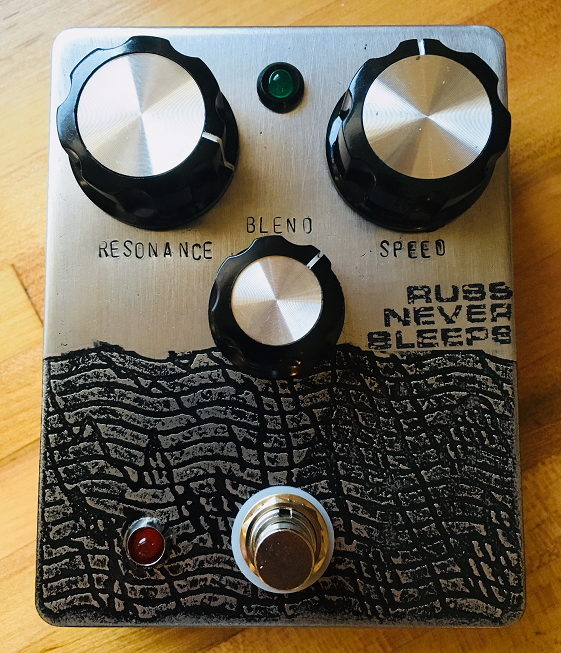Featured Build: The Harmonic Percolator
Posted by Rebecca on Jul 20th 2018
Welcome to Featured Build! We're talking to guitar pedal builders and Makers of Things about what they do and how they do it, plus the tips and tricks they've learned along the way.
When we first saw this Harmonic Percolator from Russ Bryan (who builds under the name Russ Never Sleeps), we knew we had to talk to him about this simple but eye-catching enclosure. Turns out, he is a master at etching, which is no easy feat. Getting the results you want from the process takes focus, persistence, and lots of practice.
The Build
Harmonic Percolator fuzz pedal
Russ Bryan of Russ Never Sleeps, New Albany, Indiana

Why etching?
Russ: I tend to appreciate the aesthetic quality that old, well-played gear has and so I have never tried to make my pedals have flawless finishes. Etching is a lot of fun because it is destructive by nature, and it can recreate some of that worn-look without being intentional about it.
What design principles work best?
Russ: The design I use on a lot of my pedals comes from the inside of a security envelope. I just opened up a bill one day and said, "Hey, that looks really cool." I actually know nothing of graphic design as done on these electronic computer boxes; I did well just to edit that envelope design in MS Paint.
What is your technique?
Russ: I use the toner-transfer method for putting the resistant layer on the enclosure, and then I use a mix of muriatic acid and hydrogen peroxide for the etchant solution.
I don't etch any of my lettering or knob labels, rather I do all of that with hammer stamps.
Then, the enclosure gets sprayed with black spray paint, I sand off the paint and leave the etched/stamped parts well filled with paint.
I clear-coat with Bullseye Shellac. I've used a bunch of different spray finishes for the clear coat, and I've found that one to be my favorite.


Maestro Filter / Sample and Hold clone without filter section and added clean blend [PCB designed by DC6fx] (top) and Function FX Clusterfuzz clone with added blend (bottom), by Russ Never Sleeps.
Any tips for getting best results?
Russ: I have no tips for etching enclosures with perfect finishes. However, I would encourage any newcomers to etching to embrace the mistakes and learn to work around them.
My first attempt at etching was trying to put a Marshall logo on a crunch box clone, and even though it looked decent, I wasn't satisfied because the Marshall logo is just so recognizable and it needs to be just right. With weird abstract designs no one really knows what it's supposed to look like, so however it comes out is the way it should be!
***
For more information on a custom build by Russ (or if you just want to talk shop), message Russ Never Sleeps on Instagram @russ_never_sleeps or send an email to SeriousAsAHeartAttack@gmail.com.
Note: Be smart when using etching chemicals and always follow best practices for safety (like using thick gloves and eye protection). Read yer labels!

